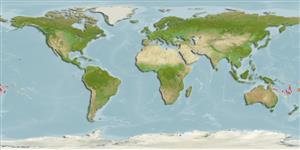>
Blenniiformes (Blennies) >
Blenniidae (Combtooth blennies) > Salariinae
Etymology: Ecsenius: Greek, exenios, -os, -on = uncontrolled, immoderate.
Environment: milieu / climate zone / depth range / distribution range
Ecologia
marinhas demersal; intervalo de profundidade 0 - 14 m (Ref. 5296). Tropical
Western Central Pacific: Rotuma (Fiji) and Tutuila, American Samoa.
Tamanho / Peso / Idade
Maturity: Lm ? range ? - ? cm
Max length : 4.5 cm SL macho/indeterminado; (Ref. 5296)
Descrição breve
Morfologia | Morfometria
Espinhos dorsais (total): 12; Raios dorsais moles (total): 13-15; Espinhos anais 2; Raios anais moles: 14 - 16; Vértebras: 31 - 34. Dorsal fin XII,13-15 (usually 14), spinous and segmented-ray with deep notch in-between. Anal fin II,14-16 (typically 16). Pectoral fin 12 or 13 (typically 13). Segmented caudal-fin rays 13. Vertebrae 10 + 21-24 (typically 23). Dentary incisor teeth 48-57 which includes anterior canine teeth very similar in appearance with incisors; posterior canines 0 or 1 on each side (rarely 0). Lateral line lacking vertical pairs of pores, terminating posteriorly at point between vertical from interspace between dorsal-fin spines 10 and 11 and vertical from spine 12 (rarely anterior to spine 11). With cirrus on posterior rim of anterior nostril; absent on anterior rim. Dorsal row of dark spots below segmented-ray portion of dorsal fin usually saddle-like; space between pair of dorsal dark body spots just posterior to vertical from anteriormost (of 3) dark spot of ventral row narrower than space between second spot of pair and next spot posteriorly; slender, pale stripe extending most of midbody length usually present; dark spots on posterior half of body often not surrounded by conspicuous, discrete, pale rings (diffuse or faintly pale rings often
present around spots) (Ref. 5296).
Specimens collected from the ocean side of reef crest with rock and dead coral and some live coral (Ref. 5296). Oviparous. Eggs are demersal and adhesive (Ref. 205), and are attached to the substrate via a filamentous, adhesive pad or pedestal (Ref. 94114). Larvae are planktonic, often found in shallow, coastal waters (Ref. 94114).
Life cycle and mating behavior
Maturidade | Reprodução | Desova | Ovos | Fecundidade | Larvas
Oviparous, distinct pairing (Ref. 205).
Springer, V.G., 1988. The Indo-Pacific blenniid fish genus Ecsenius. Smithson. Contrib. Zool. (465):134 p. (Ref. 5296)
Categoria na Lista Vermelha da IUCN (Ref. 130435)
Ameaça para o homem
Harmless
Utilização humana
Mais informação
Idade/TamanhoCrescimentoComprimento-pesoComprimento-comprimentoFrequência de comprimentoMorfometriaMorfologiaLarvasDinâmica larvarRecrutamentoAbundânciaBRUVS
ReferênciasAquaculturaPerfil para aquaculturaEstirpesGenéticaElectrophoresesHereditariedadeDoençasProcessamentoNutrientsMass conversion
ColaboradoresFotografiasStamps, Coins Misc.SonsCiguateraVelocidadeTipo de nataçãoÁrea branquialOutras referênciasCérebrosVisão
Ferramentas
Relatórios especiais
Descarregue XML
Fontes da internet
Estimates based on models
Preferred temperature (Ref.
123201): 24.9 - 29.5, mean 27.9 °C (based on 476 cells).
Phylogenetic diversity index (Ref.
82804): PD
50 = 0.5000 [Uniqueness, from 0.5 = low to 2.0 = high].
Bayesian length-weight: a=0.00741 (0.00335 - 0.01640), b=3.02 (2.83 - 3.21), in cm total length, based on LWR estimates for this (Sub)family-body shape (Ref.
93245).
Nível Trófico (Ref.
69278): 2.0 ±0.00 se; based on food items.
Resiliência (Ref.
120179): Elevada, tempo mínimo de duplicação da população menor que 15 meses (Preliminary K or Fecundity.).
Fishing Vulnerability (Ref.
59153): Low vulnerability (10 of 100).
